Karambit - Steel Claw of a Tiger
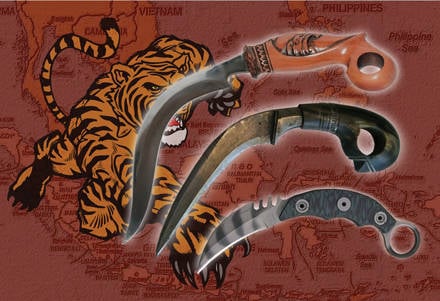
Far from Russia, on the border between the Indian and Pacific oceans is the Malay Archipelago - the largest archipelago of the world, numbering about 25 thousand of large and small islands. On the islands of the archipelago are such countries as Brunei, Indonesia, Malaysia, Timor, the Philippines, etc. Few regions of the globe can boast such a variety of blades weaponswhich was created by the peoples of this region. It was here that the famous balisong, kris, and kerambit were created. This article is dedicated to karambit, a unique knife that came from the depth of ages.
The Malay word "karambit" (pronounced kah-rahm-bit) means "tiger's claw." Although this original weapon has a centuries-old historyIn the West, it became widely known only at the end of the 70-s - the beginning of the 80-s of the last century.
In foreign literature, the names of carambit, corambit, or kerambit have been attached to it (the latest version of the name has taken root in the domestic literature, which will be used in this article).
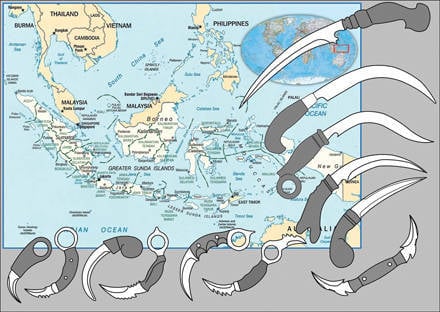
At home, this knife has many varieties and is known by the most diverse names - “kuk makan”, “kuk bima”, “kuk hanuman”, “lombok”, “lenkong payak”, “lavi ayem”, “sumba” and others These knives differ from each other in size, degree of curvature of the blade, the presence or absence of a ring at the end of the handle. Common to all these knives is a double-edged crescent blade without a guard and a handle with a thickening at the end or a ring. In this case, the knife has the shape of the letter "C" or "G" (Lenkong Payak). Some karabits had a longitudinal notch on the blade, which was used to capture the blade of the enemy. There were also kerabits with two blades.
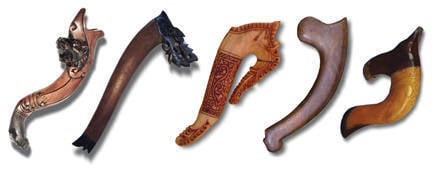
The kerambit blade was forged from carbon steel. As a material for the manufacture of handles served hard wood or animal horns. Sheaths were usually made of wood, repeated the shape of the kerambit blade and were decorated with ornaments. They had no suspension - the kerambit was worn tucked into a belt.
The kerabita knives served as the basis for creating special bulang blades and tari (tari), which were tied to the legs of roosters during cockfighting.
The origin history of kerambit
The origin of kerambit, the first mention of which dates back to the XII - XIII centuries, is fanned by legends, and the true history of its birth, as well as the place of its birth, can hardly be established now.
According to one of the legends, the population of the kingdom of Sunda (or Sundanezi), which was located in the place of modern Indonesia, had a cult of the tiger - the strongest and most ferocious inhabitant of the jungle. They believed that the spirit of their king, the ruler, after death, goes into the jungle and infuses into the body of a tiger — the harimau or the great tamaka (pak macan). They copied the shape of the claws of a tiger for a large heavy combat knife with a sickle blade, which was called “kuk makan” (tiger claw).
Another legend about the origin of kerambit is associated with the penetration of the islands of the Malay Archipelago of Hinduism. The form of the crescent blade of kerambit was associated with Bima and Hanuman, the heroes of the main sacred ancient Indian eposes, Mahabharata (the great tale of the descendants of King Bharata) and Ramayana (Journey of Rama). Bima is a fierce demon whose main weapons were his claws and a mace, and Hanuman is the legendary monkey king, whose magic claw grew in the center of his palms. The claw was perceived as a symbol of Indonesian martial art, Pecak Silat (Pencak Silat), and, according to legend, it was he who served as the basis for the creation of combat kerabit, known as the Bimah Kuk (Han's Claw) or the Hanuman Khuk.
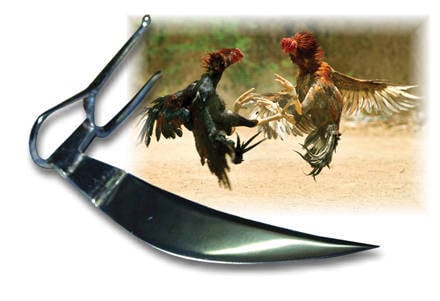
Some experts believe that the kerambit blade form was borrowed from the Jambiya dagger, which was brought to the islands of the archipelago by the ancient Arabs.
However, most likely, an ordinary agricultural sickle was a prototype of kerambit, and the ring on its handle had the most prosaic purpose — to prevent its falling into water when working in the rice fields. This version is also supported by the presence of bladed weapons in this region, which almost completely repeats the shape of the sickle - “clurit” (or “cellulite”).
In earlier times, before the battle, the edge of the battle kerambit was usually smeared with various types of deadly poison, which acted almost instantly, penetrating the blood through the lacerations caused by these weapons. To do this, even there were special teeth on the butt of the blade. A small cut was enough to penetrate the poison into the blood of the enemy and his quick death. The knowledge and use of poisons derived from various types of poisonous frogs, snakes, scorpions and spiders was considered an essential element of the arsenal and skills of a real warrior.
Along with large and heavy combat kerabits, there were also smaller kerambits that were used as a household knife and a means of personal self-defense. Losing to their combat counterparts in size, these knives had much greater maneuverability. Small sized karambits, up to samples with a very small blade size, are called “lavi ayeem” (a spur of a rooster or a spur of a chicken). The handle of such kerabits, as a rule, has a ring on the end of the handle. At the same time, large combat cerambit was usually held in direct grip, while small ones were held back.
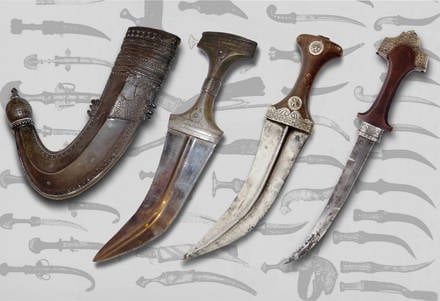
The emergence and spread of firearms has led to the almost complete disappearance of large combat karabits, and small karabits are still widespread in the region as a personal weapon of self-defense and a household knife, becoming an integral attribute of martial arts practiced in the countries of the archipelago.
Modern kerabits and their varieties
For the first time kerambits appeared in the USA in the 1950s. together with immigrants from Southeast Asia. But their appearance went unnoticed. Few could see in this small knife with a curved blade and an incomprehensible ring on the handle its unique combat capabilities. Only at the end of 70 - the beginning of 80-s of the last century thanks to the demonstration performances of martial arts masters of Southeast Asia (Indonesian Penchak Silat, Philippine Kali and Malaysian Bursilat), which also demonstrated the technique of using kerambit in combat, in the West a real karambit boom began.
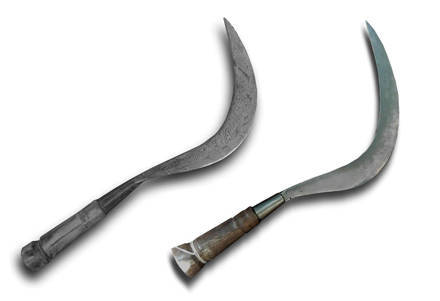
This was largely due to the unique properties of kerambit, which fit well into the main trend in the development of personal self-defense knives - reducing the size of the blade and moving from the injection to cutting.
Further development of kerabits in the western knife industry took place in three directions:
- the creation of traditional kerabits for those practicing in the martial arts systems of the Malayan archipelago;
- the use of separate elements of keramite in knives;
- a combination of new types of knives, combining the structural elements of kerambit with the structural elements of other known knives;
- the creation of new types of knives, combining the structural elements of kerambit with the structural elements of other known knives.
Traditional form karabits
The design of the knife, which in modern Western knife industry is designated by the term karabit, was canonized by the American Steve Tarani, the creator of the modern version of knife fight with kerambit, Modern Karambit Method. The form of kerambit Tarani corresponds to the shape of short Filipino kerambits (lavi ayeem - a spur of a rooster or a spur of a chicken) with a ring on the handle.
In its classic form, Karambit Tarani was implemented in metal by Duane Dwyer and Mick Strider, the founders of the famous American company Strider Knives, Inc.. The total length of the knife is 20 cm with the length of the blade 8 cm (thickness of the butt - 5,4 mm), weight 156 grams. The blade of the knife has a two-sided sharpening, and not only the butt is sharpened, but also the teeth on the butt.
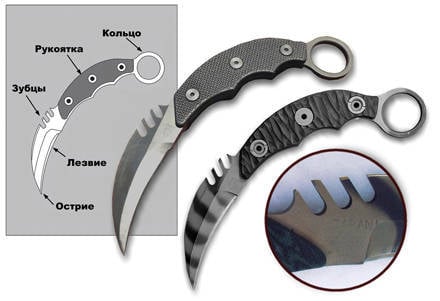
It is this design of kerambit that allows you to fully use the entire arsenal of techniques and gives the knife unique features - low visibility in the hand and a very reliable grip (it is almost impossible to knock it out of your hand).
Most modern karabits produced by Western companies are somewhat different from Tarani kerambit. First of all, the lack of bilateral sharpening on the butt, due to legal restrictions. In addition, the teeth on the butt of the knife are often replaced by a large notch or figured protrusions, and the ring is complemented by a notch, a special shock protrusion (or projections), which makes it possible to enhance the effectiveness of the impact actions by the end of the handle.
In the Atomic kerambit kerambit, the famous designer of tactical knives, Lazi Szabo, is about 3 cm long. This not only increases the impact force significantly, but also makes it more comfortable to hold kerambit by the ring.
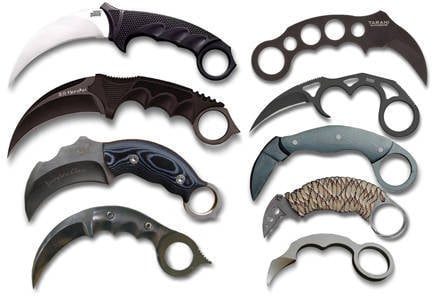
The classical form of kerabits described above is intended primarily for adherents of martial arts. For use as a personal self-defense weapon in the city, kerambits with reduced blade length, including a simplified skeletal structure, are produced.
One of the disadvantages of kerabits with a fixed blade is their dimensions, which makes it inconvenient for a city resident to wear. Therefore, at present, folding kerabs have been widely commissioned, which are present in the catalogs of almost all known knife companies.
In order to quickly reveal kerambit in a critical situation, Emerson supplied its products with a special device on the blade's butt in the form of a small hook, which provides automatic opening of the blade when the knife is taken out of the pocket. Semi-automatic kerambits are also produced, in which, after a slight shift, the blade is quickly brought to the working position with the help of a special spring.
Karambit-like knives
Karambit like knives, in which the shape of the blade or the location of the ring is different from the classical form of kerambit Tarani.
These knives often include knives, the only difference of which is the absence of a ring in the top of the handle. However, this is not entirely fair, since such a construction of kerambit existed in its homeland. First of all, it was characteristic of large battle kerabits, although there were also small kerabits without a ring.
Some experts believe that in the Philippines such a ring was banned by the Spaniards. The absence of a ring somewhat narrows the arsenal of technical actions with kerambit, since it makes it impossible to conduct brass-like blows with a ring and does not allow holding hooks while holding kerambite behind the ring. But at the same time, instead of strikes with a ring, strikes with the base of the blade handle are possible, and the absence of a ring allows you to quickly move from the reverse grip to the forward one.
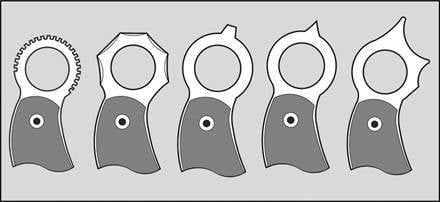
Knives that use non-sickle-shaped blades, knives with a complex blade configuration, including the concave part, as well as having additional structural elements, with a ring in the region of the blade and handle, as well as two rings, can be considered as really karambit-like.
Introduction to the design of knives (both with a fixed and folding blade) of one or two rings, of course, allows you to increase the reliability of his grip and does not allow you to knock the knife out of your hand. In addition, this design change extends the functionality of the knife, allowing it to be used as a percussion weapon. However, this has to be paid for by the inability to quickly change the grip of the knife during the fight.
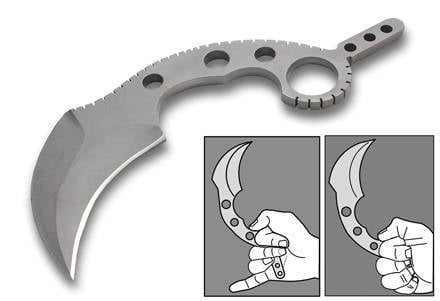
The increased cutting properties of the sickle blade were used to create small knives of the neckline for personal self-defense. In this case, the ring was moved to the boundary between the blade and the handle. These knives were intended for use as a tool for personal self-defense, as well as for those people whose work or passion is connected with cutting ropes or cords (tourists, climbers, hunters, etc.). Such karambit-like knives are available in two versions - with a regular and gray blade. They do an excellent job with the opening of various packages, with which every urban resident faces. Their dignity as a subject of personal self-defense lies in the fact that for their use there is no need for special training in keeping the knife with a direct grip. In this case, even the chaotic strikes can inflict many cuts to the attacker, not life-threatening, but having a great psychological effect.
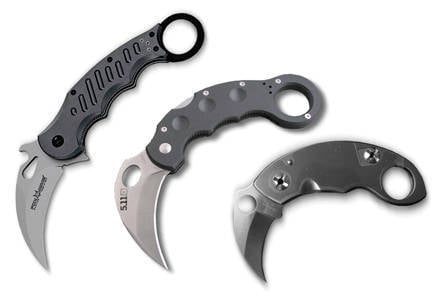
Further development of the idea of using a kerambit ring was realized when creating small self-defense knives with small blades of the most varied shape. In some such products, the handle itself may not be present at all.
New types of knives
The combination of the elements of kerambit and balisong in the design of the knife gave birth to the knife, which was called “kerambitsong”. And as a result of combining the Philippine knives of barong and Malaysian kerabits in one design by the American designer Richard Derespina, Parong Carambit was created.
The combination of the elements of the Japanese knife tanto and kerambit in one blade underlies one of the best modern knives designed for personal self-defense - RRB (Reality-Based Blade) by German hand-to-hand combat expert Jim Wagner.
Among the brass knuckles and brass weapons there are models with a small sickle blade.
Information